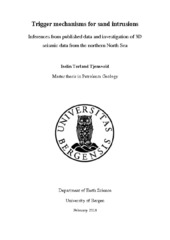| dc.description.abstract | Numerous publications have addressed subsurface sediment remobilization, in terms of geometries of the intrusions, where the intrusions occur, the parent unit of the intrusions and trigger mechanisms. Several authors have suggested different trigger mechanisms. The most frequently suggested trigger mechanism is earthquake induced liquefaction, but the suggestion is rarely well supported by evidence. This thesis has investigated the possibility of a link between trigger mechanisms and the tectonic setting of the basin where sand intrusions occur. Several basins worldwide were investigated, and revealed an overrepresentation of subsurface sediment remobilization at convergent margins (including transform margins) and inverted passive margins. Convergent margins tend to show a relatively steep slope, and hence lateral pressure transfer was proposed as an important trigger mechanism at this type of tectonic setting. The subduction of the oceanic plate causes a step-wise compression of the deep sediments, and consequently the fluids are forced to escape rapidly, causing lateral fluid transfer to shallower strata. This process can result in rapid build-up of fluid pressures exceeding the lithostatic stress in the shallowest positions of the dipping (and permeable) strata, and trigger sand injections here. Investigations of 3D seismic data from the northern North Sea was carried out to examine trigger mechanisms of sand intrusions at inverted passive margins. One phase of subsurface sediment remobilization was recognized within the Early Oligocene to Mid Miocene succession. Several evidence point towards one alternative to a trigger mechanism causing subsurface sediment remobilization in the northern North sea: 1) remobilization took place along the basin-flank transition, but not in the basin center, 2) a detachment surface was interpreted along the base of the subsurface sediment remobilization, and pose a good candidate as the slide plane, 3) mounds are arranged in N-S trending ridges along the basin-flank transition, and are hence parallel to the eastern margin and a potential headwall scarp, 4) liquefaction of mud and sand are triggered by shearing, 5) the interpreted slide plane is parallel to the bedding. Accordingly, shearing along the slope caused by a submarine slab slide was suggested as the main trigger mechanism of subsurface sediment remobilization in the northern North Sea. Submarine slab slides represent sedimentary processes that are common on inverted passive margins. Consequently, the interpretation is considered at least partly applicable to other inverted passive margins worldwide. | en_US |
